MGT3203 - Cross-Cultural Management: A Critical Evaluation of Studies
VerifiedAdded on 2023/06/13
|11
|2255
|424
Essay
AI Summary
This essay provides a comprehensive analysis of cross-cultural management by critically evaluating two journal articles. It examines the research methods, data analysis techniques, and findings of each article, focusing on cultural intelligence, global leadership, and diversity management. The essay also discusses the challenges and benefits of cross-cultural management in international business. The analysis includes a comparison of positivism and interpretivism research philosophies, quantitative and qualitative data analysis techniques, and the application of Hofstede's cultural dimensions. The study concludes with recommendations for overcoming limitations in the reviewed articles and enhancing cross-cultural communication and training within organizations. Desklib offers a wide range of resources, including past papers and solved assignments, to support students in their academic pursuits.
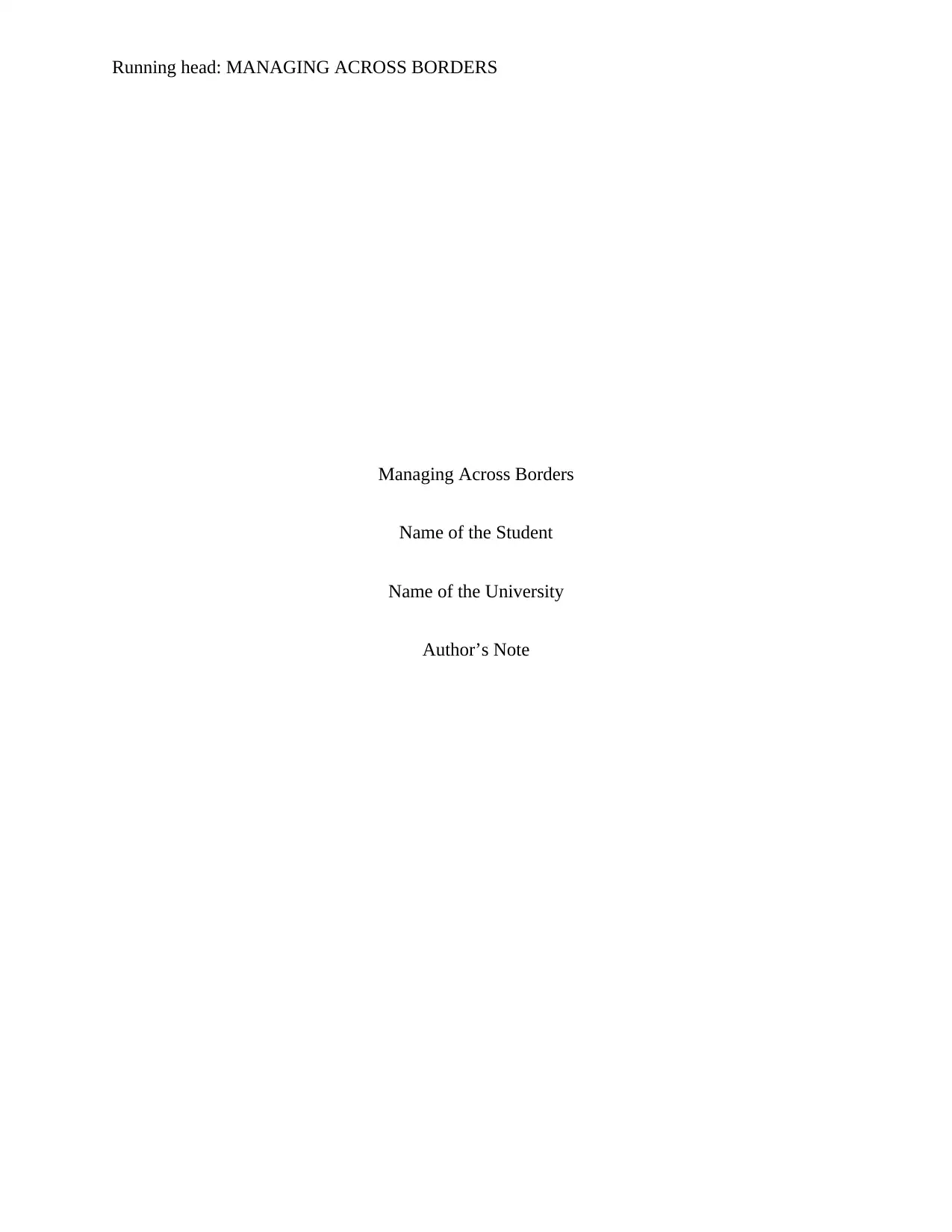
Running head: MANAGING ACROSS BORDERS
Managing Across Borders
Name of the Student
Name of the University
Author’s Note
Managing Across Borders
Name of the Student
Name of the University
Author’s Note
Paraphrase This Document
Need a fresh take? Get an instant paraphrase of this document with our AI Paraphraser
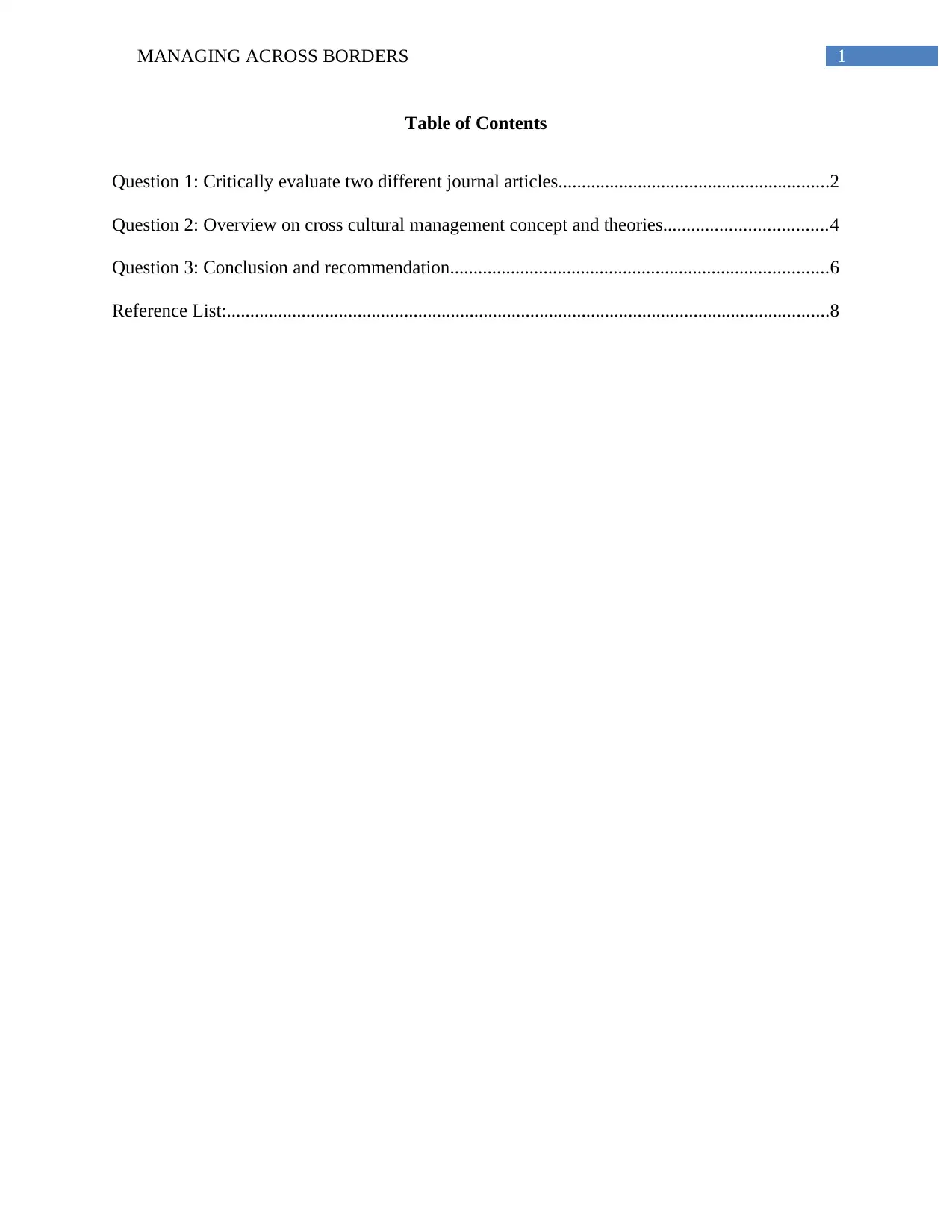
1MANAGING ACROSS BORDERS
Table of Contents
Question 1: Critically evaluate two different journal articles..........................................................2
Question 2: Overview on cross cultural management concept and theories...................................4
Question 3: Conclusion and recommendation.................................................................................6
Reference List:.................................................................................................................................8
Table of Contents
Question 1: Critically evaluate two different journal articles..........................................................2
Question 2: Overview on cross cultural management concept and theories...................................4
Question 3: Conclusion and recommendation.................................................................................6
Reference List:.................................................................................................................................8
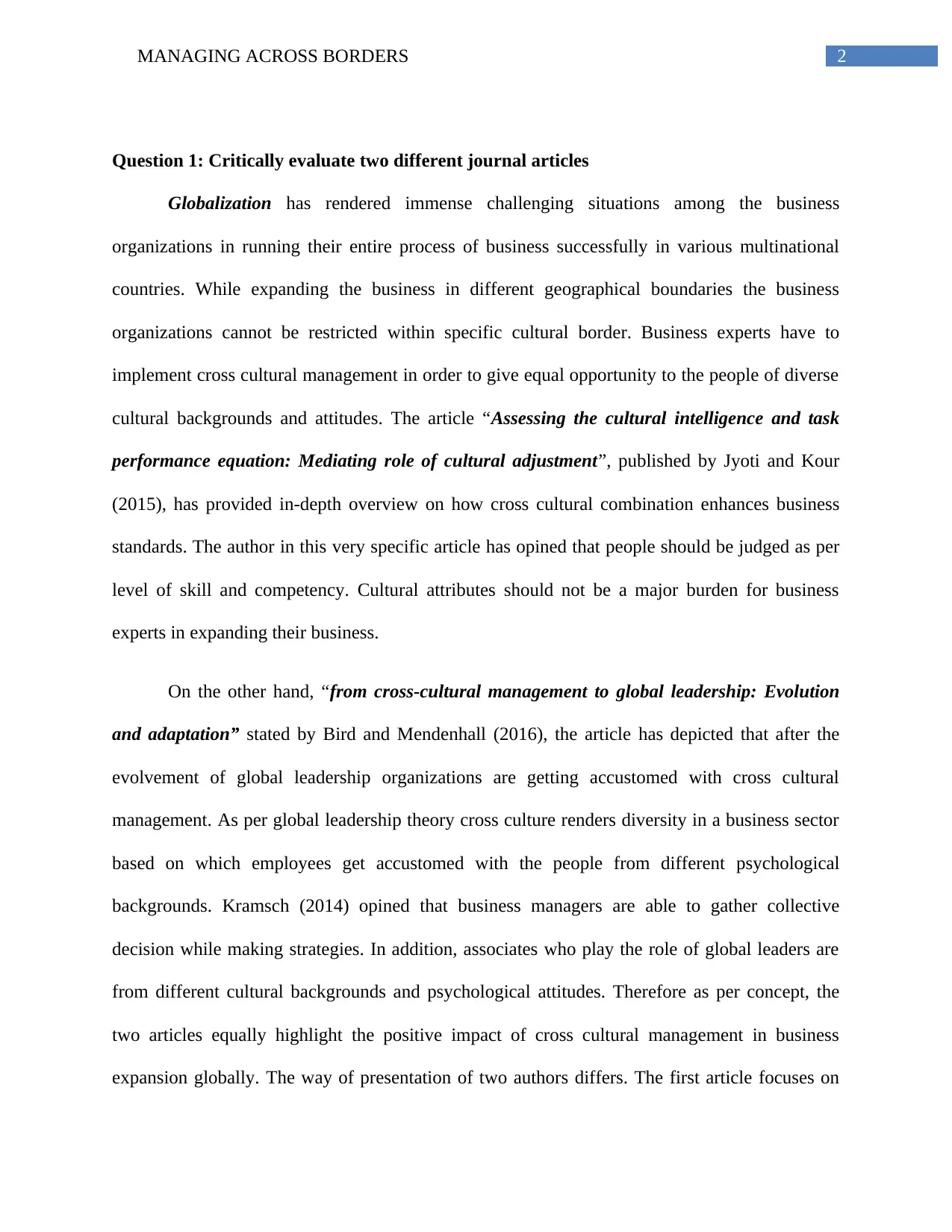
2MANAGING ACROSS BORDERS
Question 1: Critically evaluate two different journal articles
Globalization has rendered immense challenging situations among the business
organizations in running their entire process of business successfully in various multinational
countries. While expanding the business in different geographical boundaries the business
organizations cannot be restricted within specific cultural border. Business experts have to
implement cross cultural management in order to give equal opportunity to the people of diverse
cultural backgrounds and attitudes. The article “Assessing the cultural intelligence and task
performance equation: Mediating role of cultural adjustment”, published by Jyoti and Kour
(2015), has provided in-depth overview on how cross cultural combination enhances business
standards. The author in this very specific article has opined that people should be judged as per
level of skill and competency. Cultural attributes should not be a major burden for business
experts in expanding their business.
On the other hand, “from cross-cultural management to global leadership: Evolution
and adaptation” stated by Bird and Mendenhall (2016), the article has depicted that after the
evolvement of global leadership organizations are getting accustomed with cross cultural
management. As per global leadership theory cross culture renders diversity in a business sector
based on which employees get accustomed with the people from different psychological
backgrounds. Kramsch (2014) opined that business managers are able to gather collective
decision while making strategies. In addition, associates who play the role of global leaders are
from different cultural backgrounds and psychological attitudes. Therefore as per concept, the
two articles equally highlight the positive impact of cross cultural management in business
expansion globally. The way of presentation of two authors differs. The first article focuses on
Question 1: Critically evaluate two different journal articles
Globalization has rendered immense challenging situations among the business
organizations in running their entire process of business successfully in various multinational
countries. While expanding the business in different geographical boundaries the business
organizations cannot be restricted within specific cultural border. Business experts have to
implement cross cultural management in order to give equal opportunity to the people of diverse
cultural backgrounds and attitudes. The article “Assessing the cultural intelligence and task
performance equation: Mediating role of cultural adjustment”, published by Jyoti and Kour
(2015), has provided in-depth overview on how cross cultural combination enhances business
standards. The author in this very specific article has opined that people should be judged as per
level of skill and competency. Cultural attributes should not be a major burden for business
experts in expanding their business.
On the other hand, “from cross-cultural management to global leadership: Evolution
and adaptation” stated by Bird and Mendenhall (2016), the article has depicted that after the
evolvement of global leadership organizations are getting accustomed with cross cultural
management. As per global leadership theory cross culture renders diversity in a business sector
based on which employees get accustomed with the people from different psychological
backgrounds. Kramsch (2014) opined that business managers are able to gather collective
decision while making strategies. In addition, associates who play the role of global leaders are
from different cultural backgrounds and psychological attitudes. Therefore as per concept, the
two articles equally highlight the positive impact of cross cultural management in business
expansion globally. The way of presentation of two authors differs. The first article focuses on
⊘ This is a preview!⊘
Do you want full access?
Subscribe today to unlock all pages.

Trusted by 1+ million students worldwide
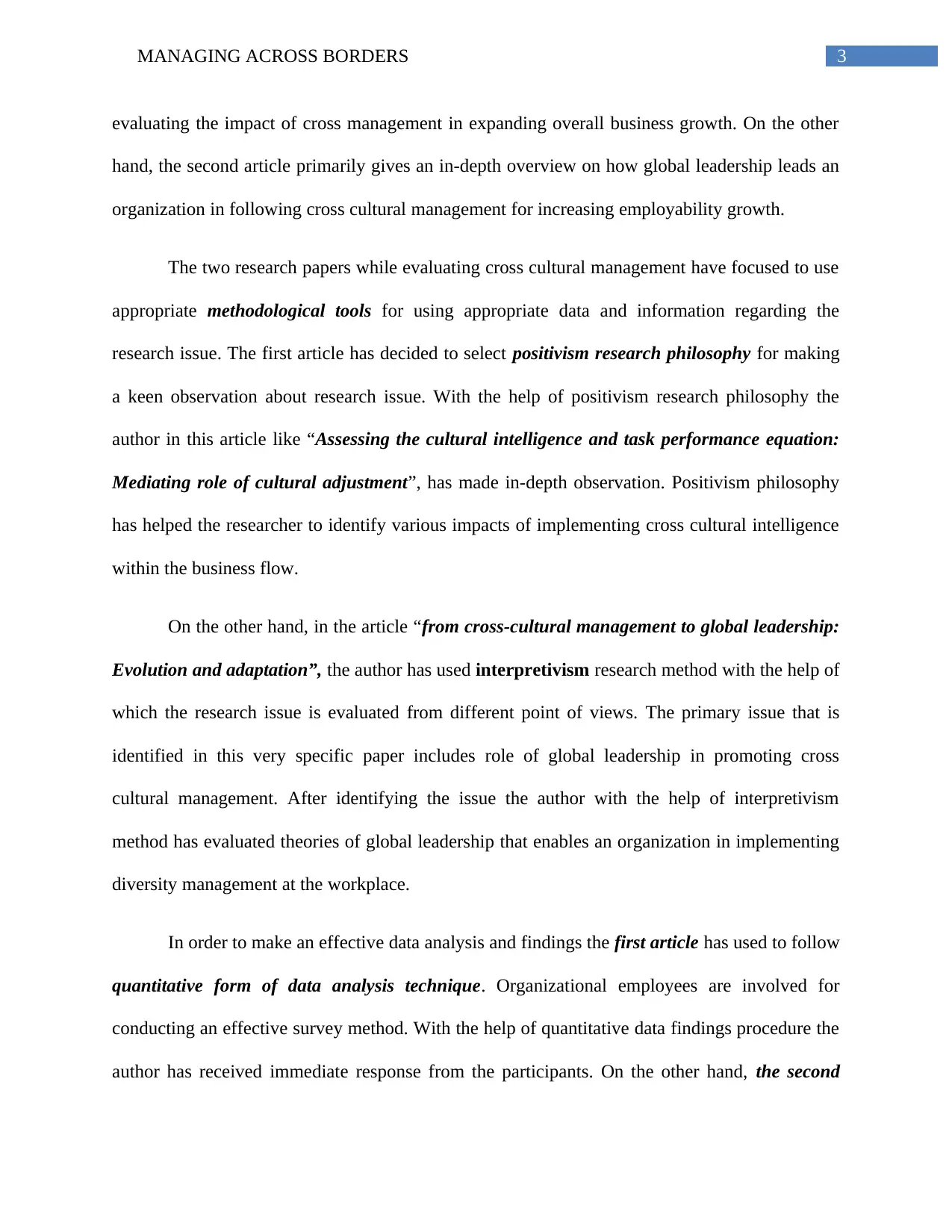
3MANAGING ACROSS BORDERS
evaluating the impact of cross management in expanding overall business growth. On the other
hand, the second article primarily gives an in-depth overview on how global leadership leads an
organization in following cross cultural management for increasing employability growth.
The two research papers while evaluating cross cultural management have focused to use
appropriate methodological tools for using appropriate data and information regarding the
research issue. The first article has decided to select positivism research philosophy for making
a keen observation about research issue. With the help of positivism research philosophy the
author in this article like “Assessing the cultural intelligence and task performance equation:
Mediating role of cultural adjustment”, has made in-depth observation. Positivism philosophy
has helped the researcher to identify various impacts of implementing cross cultural intelligence
within the business flow.
On the other hand, in the article “from cross-cultural management to global leadership:
Evolution and adaptation”, the author has used interpretivism research method with the help of
which the research issue is evaluated from different point of views. The primary issue that is
identified in this very specific paper includes role of global leadership in promoting cross
cultural management. After identifying the issue the author with the help of interpretivism
method has evaluated theories of global leadership that enables an organization in implementing
diversity management at the workplace.
In order to make an effective data analysis and findings the first article has used to follow
quantitative form of data analysis technique. Organizational employees are involved for
conducting an effective survey method. With the help of quantitative data findings procedure the
author has received immediate response from the participants. On the other hand, the second
evaluating the impact of cross management in expanding overall business growth. On the other
hand, the second article primarily gives an in-depth overview on how global leadership leads an
organization in following cross cultural management for increasing employability growth.
The two research papers while evaluating cross cultural management have focused to use
appropriate methodological tools for using appropriate data and information regarding the
research issue. The first article has decided to select positivism research philosophy for making
a keen observation about research issue. With the help of positivism research philosophy the
author in this article like “Assessing the cultural intelligence and task performance equation:
Mediating role of cultural adjustment”, has made in-depth observation. Positivism philosophy
has helped the researcher to identify various impacts of implementing cross cultural intelligence
within the business flow.
On the other hand, in the article “from cross-cultural management to global leadership:
Evolution and adaptation”, the author has used interpretivism research method with the help of
which the research issue is evaluated from different point of views. The primary issue that is
identified in this very specific paper includes role of global leadership in promoting cross
cultural management. After identifying the issue the author with the help of interpretivism
method has evaluated theories of global leadership that enables an organization in implementing
diversity management at the workplace.
In order to make an effective data analysis and findings the first article has used to follow
quantitative form of data analysis technique. Organizational employees are involved for
conducting an effective survey method. With the help of quantitative data findings procedure the
author has received immediate response from the participants. On the other hand, the second
Paraphrase This Document
Need a fresh take? Get an instant paraphrase of this document with our AI Paraphraser
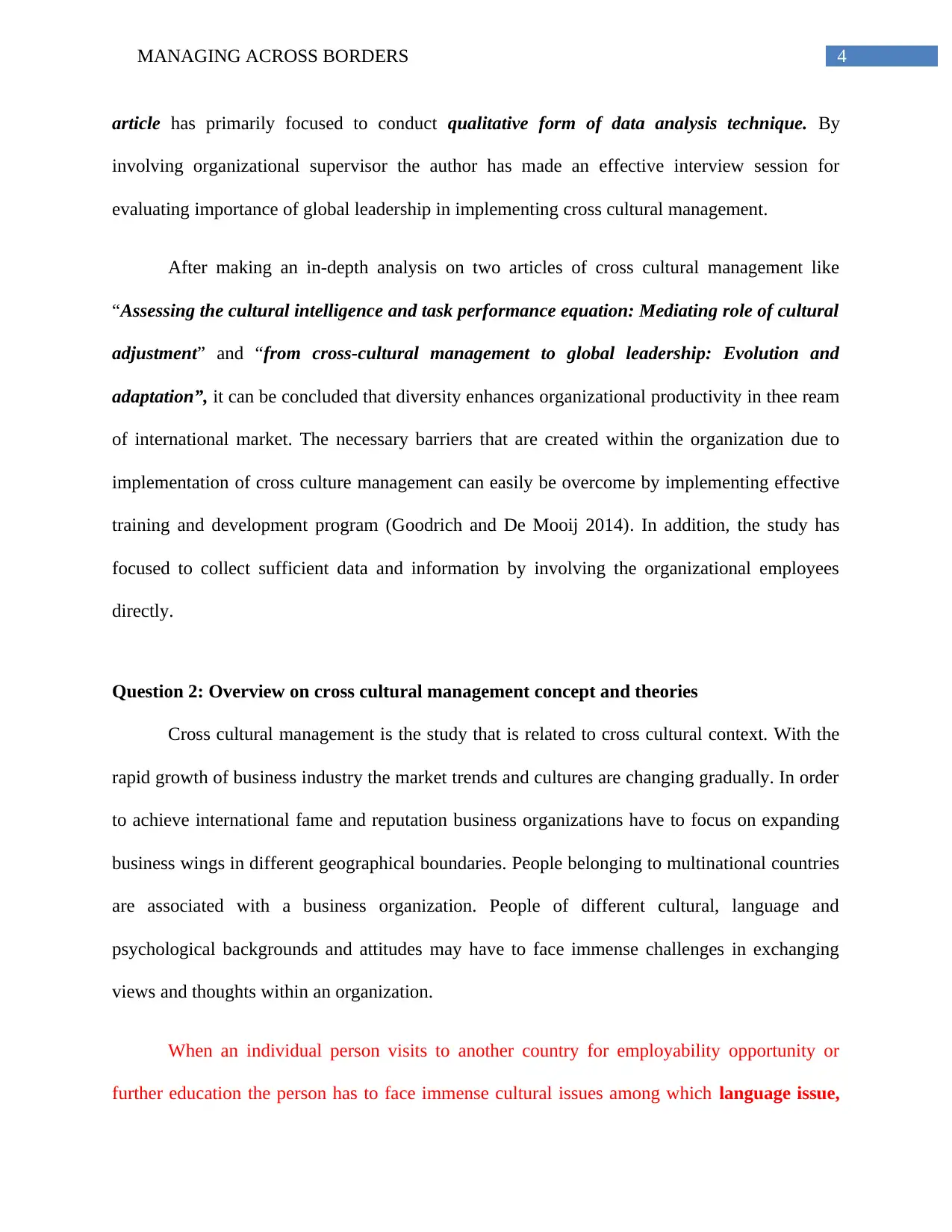
4MANAGING ACROSS BORDERS
article has primarily focused to conduct qualitative form of data analysis technique. By
involving organizational supervisor the author has made an effective interview session for
evaluating importance of global leadership in implementing cross cultural management.
After making an in-depth analysis on two articles of cross cultural management like
“Assessing the cultural intelligence and task performance equation: Mediating role of cultural
adjustment” and “from cross-cultural management to global leadership: Evolution and
adaptation”, it can be concluded that diversity enhances organizational productivity in thee ream
of international market. The necessary barriers that are created within the organization due to
implementation of cross culture management can easily be overcome by implementing effective
training and development program (Goodrich and De Mooij 2014). In addition, the study has
focused to collect sufficient data and information by involving the organizational employees
directly.
Question 2: Overview on cross cultural management concept and theories
Cross cultural management is the study that is related to cross cultural context. With the
rapid growth of business industry the market trends and cultures are changing gradually. In order
to achieve international fame and reputation business organizations have to focus on expanding
business wings in different geographical boundaries. People belonging to multinational countries
are associated with a business organization. People of different cultural, language and
psychological backgrounds and attitudes may have to face immense challenges in exchanging
views and thoughts within an organization.
When an individual person visits to another country for employability opportunity or
further education the person has to face immense cultural issues among which language issue,
article has primarily focused to conduct qualitative form of data analysis technique. By
involving organizational supervisor the author has made an effective interview session for
evaluating importance of global leadership in implementing cross cultural management.
After making an in-depth analysis on two articles of cross cultural management like
“Assessing the cultural intelligence and task performance equation: Mediating role of cultural
adjustment” and “from cross-cultural management to global leadership: Evolution and
adaptation”, it can be concluded that diversity enhances organizational productivity in thee ream
of international market. The necessary barriers that are created within the organization due to
implementation of cross culture management can easily be overcome by implementing effective
training and development program (Goodrich and De Mooij 2014). In addition, the study has
focused to collect sufficient data and information by involving the organizational employees
directly.
Question 2: Overview on cross cultural management concept and theories
Cross cultural management is the study that is related to cross cultural context. With the
rapid growth of business industry the market trends and cultures are changing gradually. In order
to achieve international fame and reputation business organizations have to focus on expanding
business wings in different geographical boundaries. People belonging to multinational countries
are associated with a business organization. People of different cultural, language and
psychological backgrounds and attitudes may have to face immense challenges in exchanging
views and thoughts within an organization.
When an individual person visits to another country for employability opportunity or
further education the person has to face immense cultural issues among which language issue,
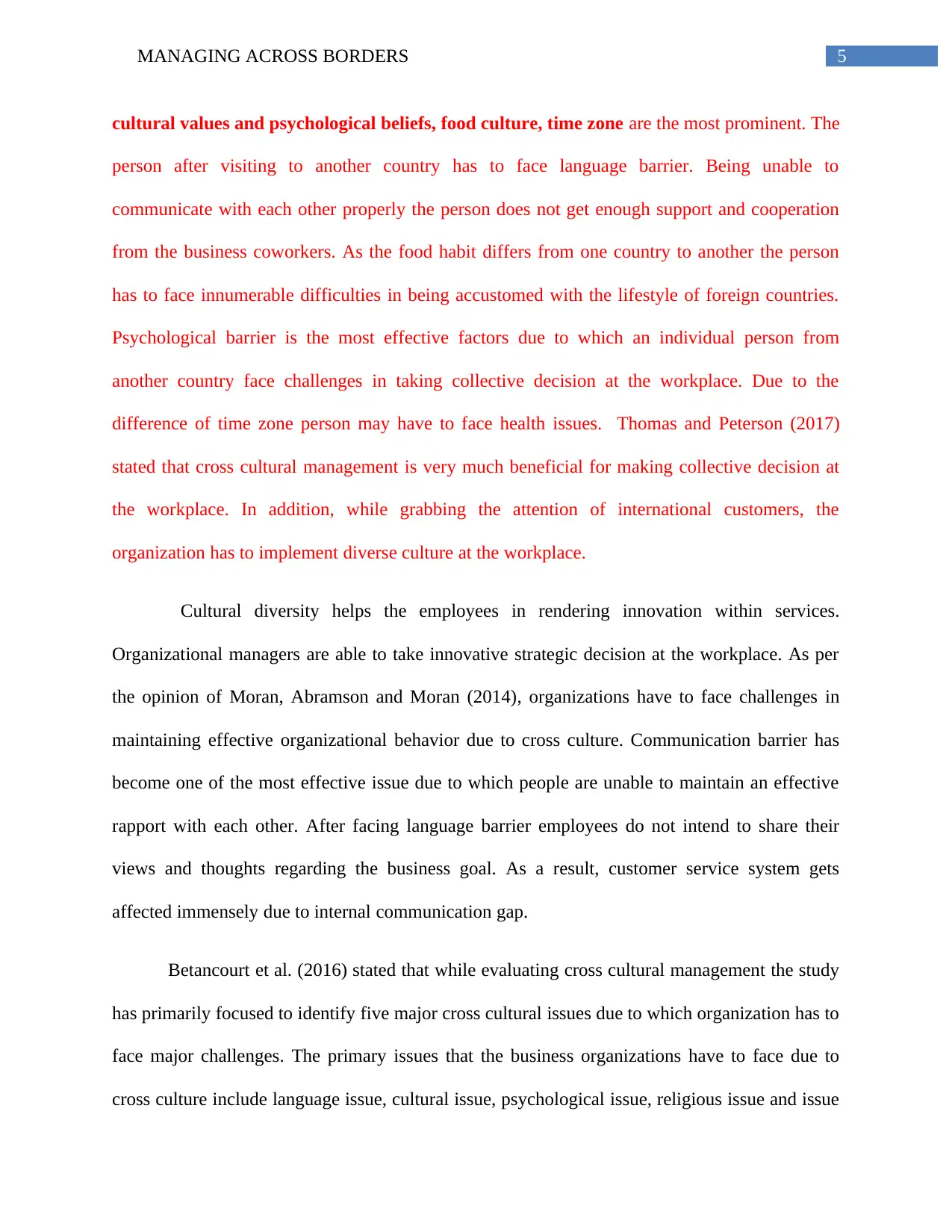
5MANAGING ACROSS BORDERS
cultural values and psychological beliefs, food culture, time zone are the most prominent. The
person after visiting to another country has to face language barrier. Being unable to
communicate with each other properly the person does not get enough support and cooperation
from the business coworkers. As the food habit differs from one country to another the person
has to face innumerable difficulties in being accustomed with the lifestyle of foreign countries.
Psychological barrier is the most effective factors due to which an individual person from
another country face challenges in taking collective decision at the workplace. Due to the
difference of time zone person may have to face health issues. Thomas and Peterson (2017)
stated that cross cultural management is very much beneficial for making collective decision at
the workplace. In addition, while grabbing the attention of international customers, the
organization has to implement diverse culture at the workplace.
Cultural diversity helps the employees in rendering innovation within services.
Organizational managers are able to take innovative strategic decision at the workplace. As per
the opinion of Moran, Abramson and Moran (2014), organizations have to face challenges in
maintaining effective organizational behavior due to cross culture. Communication barrier has
become one of the most effective issue due to which people are unable to maintain an effective
rapport with each other. After facing language barrier employees do not intend to share their
views and thoughts regarding the business goal. As a result, customer service system gets
affected immensely due to internal communication gap.
Betancourt et al. (2016) stated that while evaluating cross cultural management the study
has primarily focused to identify five major cross cultural issues due to which organization has to
face major challenges. The primary issues that the business organizations have to face due to
cross culture include language issue, cultural issue, psychological issue, religious issue and issue
cultural values and psychological beliefs, food culture, time zone are the most prominent. The
person after visiting to another country has to face language barrier. Being unable to
communicate with each other properly the person does not get enough support and cooperation
from the business coworkers. As the food habit differs from one country to another the person
has to face innumerable difficulties in being accustomed with the lifestyle of foreign countries.
Psychological barrier is the most effective factors due to which an individual person from
another country face challenges in taking collective decision at the workplace. Due to the
difference of time zone person may have to face health issues. Thomas and Peterson (2017)
stated that cross cultural management is very much beneficial for making collective decision at
the workplace. In addition, while grabbing the attention of international customers, the
organization has to implement diverse culture at the workplace.
Cultural diversity helps the employees in rendering innovation within services.
Organizational managers are able to take innovative strategic decision at the workplace. As per
the opinion of Moran, Abramson and Moran (2014), organizations have to face challenges in
maintaining effective organizational behavior due to cross culture. Communication barrier has
become one of the most effective issue due to which people are unable to maintain an effective
rapport with each other. After facing language barrier employees do not intend to share their
views and thoughts regarding the business goal. As a result, customer service system gets
affected immensely due to internal communication gap.
Betancourt et al. (2016) stated that while evaluating cross cultural management the study
has primarily focused to identify five major cross cultural issues due to which organization has to
face major challenges. The primary issues that the business organizations have to face due to
cross culture include language issue, cultural issue, psychological issue, religious issue and issue
⊘ This is a preview!⊘
Do you want full access?
Subscribe today to unlock all pages.

Trusted by 1+ million students worldwide
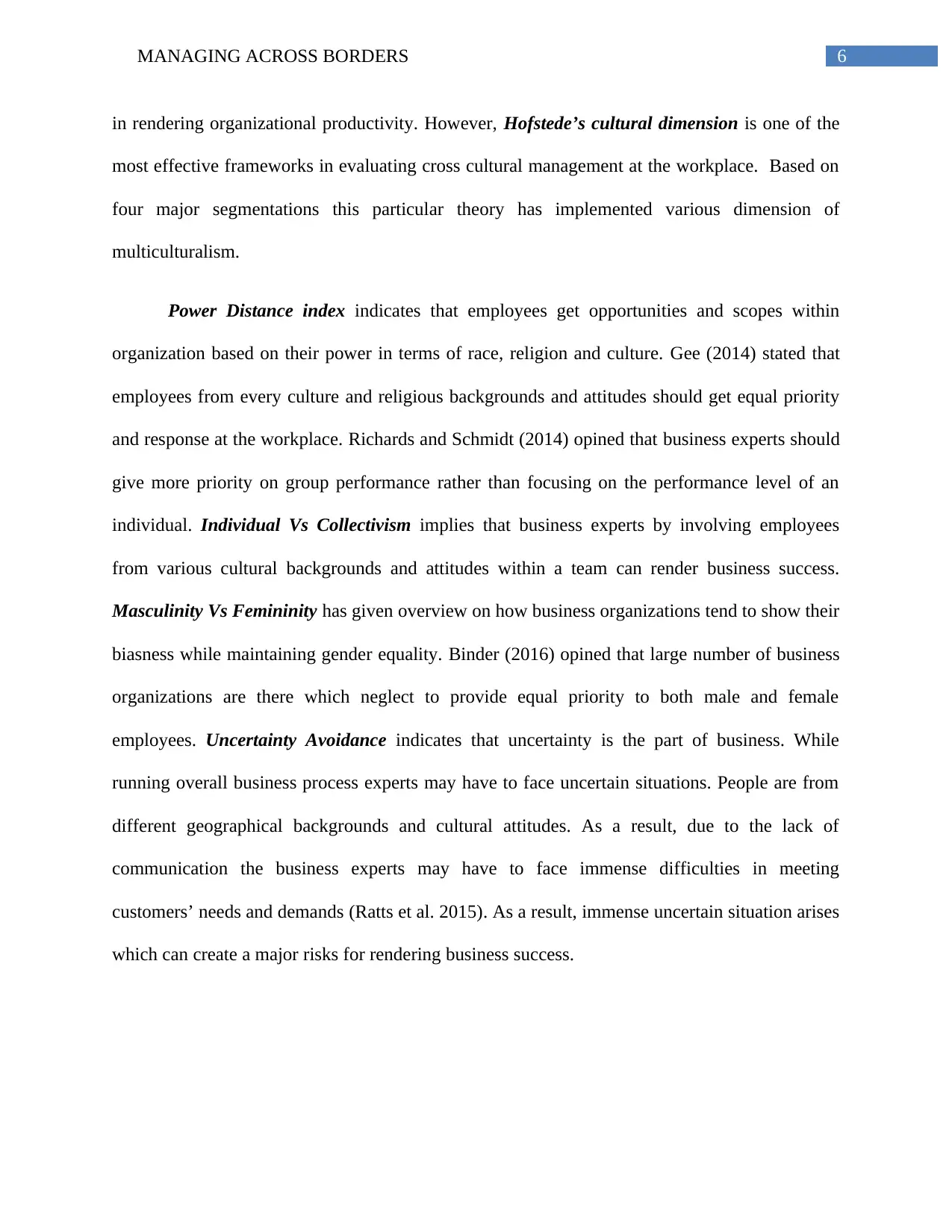
6MANAGING ACROSS BORDERS
in rendering organizational productivity. However, Hofstede’s cultural dimension is one of the
most effective frameworks in evaluating cross cultural management at the workplace. Based on
four major segmentations this particular theory has implemented various dimension of
multiculturalism.
Power Distance index indicates that employees get opportunities and scopes within
organization based on their power in terms of race, religion and culture. Gee (2014) stated that
employees from every culture and religious backgrounds and attitudes should get equal priority
and response at the workplace. Richards and Schmidt (2014) opined that business experts should
give more priority on group performance rather than focusing on the performance level of an
individual. Individual Vs Collectivism implies that business experts by involving employees
from various cultural backgrounds and attitudes within a team can render business success.
Masculinity Vs Femininity has given overview on how business organizations tend to show their
biasness while maintaining gender equality. Binder (2016) opined that large number of business
organizations are there which neglect to provide equal priority to both male and female
employees. Uncertainty Avoidance indicates that uncertainty is the part of business. While
running overall business process experts may have to face uncertain situations. People are from
different geographical backgrounds and cultural attitudes. As a result, due to the lack of
communication the business experts may have to face immense difficulties in meeting
customers’ needs and demands (Ratts et al. 2015). As a result, immense uncertain situation arises
which can create a major risks for rendering business success.
in rendering organizational productivity. However, Hofstede’s cultural dimension is one of the
most effective frameworks in evaluating cross cultural management at the workplace. Based on
four major segmentations this particular theory has implemented various dimension of
multiculturalism.
Power Distance index indicates that employees get opportunities and scopes within
organization based on their power in terms of race, religion and culture. Gee (2014) stated that
employees from every culture and religious backgrounds and attitudes should get equal priority
and response at the workplace. Richards and Schmidt (2014) opined that business experts should
give more priority on group performance rather than focusing on the performance level of an
individual. Individual Vs Collectivism implies that business experts by involving employees
from various cultural backgrounds and attitudes within a team can render business success.
Masculinity Vs Femininity has given overview on how business organizations tend to show their
biasness while maintaining gender equality. Binder (2016) opined that large number of business
organizations are there which neglect to provide equal priority to both male and female
employees. Uncertainty Avoidance indicates that uncertainty is the part of business. While
running overall business process experts may have to face uncertain situations. People are from
different geographical backgrounds and cultural attitudes. As a result, due to the lack of
communication the business experts may have to face immense difficulties in meeting
customers’ needs and demands (Ratts et al. 2015). As a result, immense uncertain situation arises
which can create a major risks for rendering business success.
Paraphrase This Document
Need a fresh take? Get an instant paraphrase of this document with our AI Paraphraser
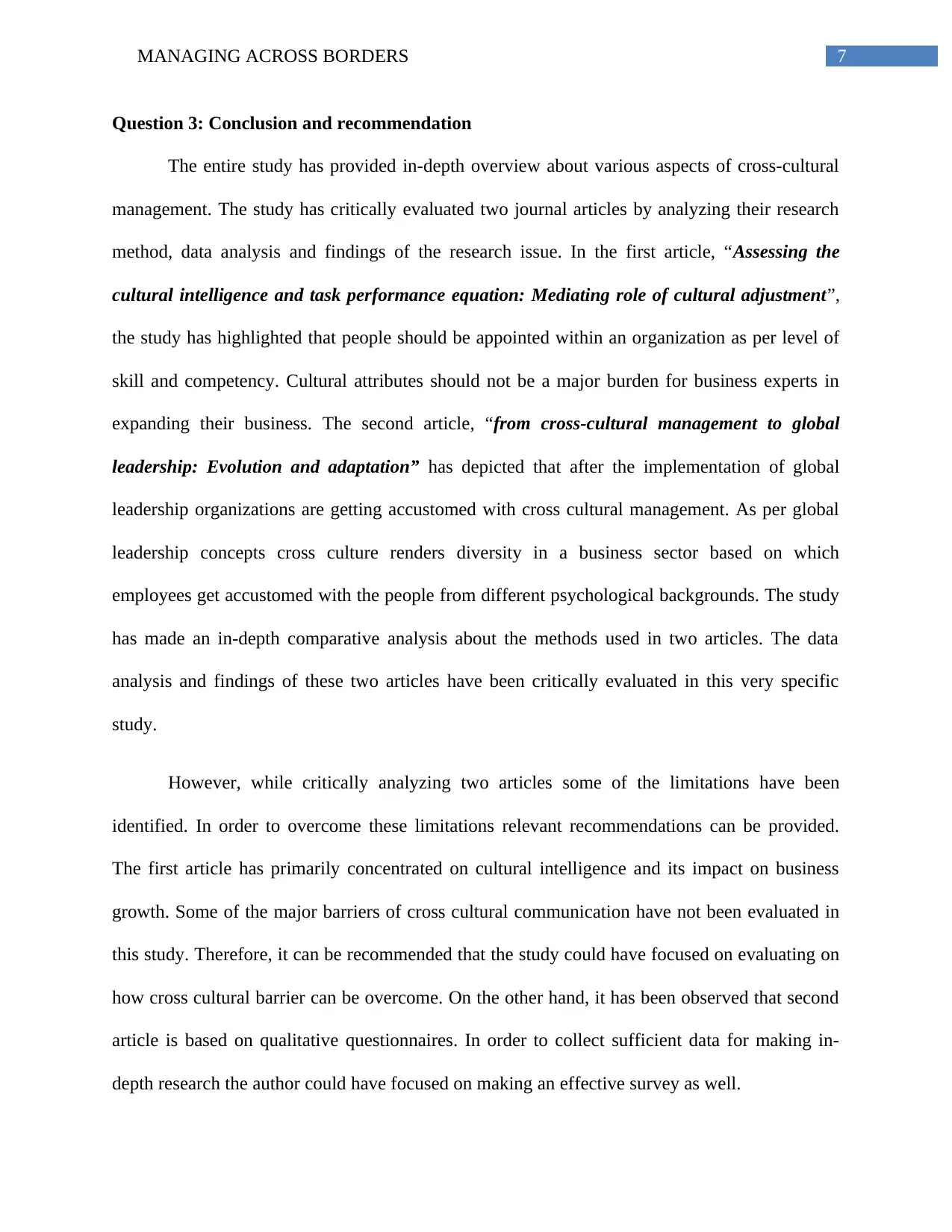
7MANAGING ACROSS BORDERS
Question 3: Conclusion and recommendation
The entire study has provided in-depth overview about various aspects of cross-cultural
management. The study has critically evaluated two journal articles by analyzing their research
method, data analysis and findings of the research issue. In the first article, “Assessing the
cultural intelligence and task performance equation: Mediating role of cultural adjustment”,
the study has highlighted that people should be appointed within an organization as per level of
skill and competency. Cultural attributes should not be a major burden for business experts in
expanding their business. The second article, “from cross-cultural management to global
leadership: Evolution and adaptation” has depicted that after the implementation of global
leadership organizations are getting accustomed with cross cultural management. As per global
leadership concepts cross culture renders diversity in a business sector based on which
employees get accustomed with the people from different psychological backgrounds. The study
has made an in-depth comparative analysis about the methods used in two articles. The data
analysis and findings of these two articles have been critically evaluated in this very specific
study.
However, while critically analyzing two articles some of the limitations have been
identified. In order to overcome these limitations relevant recommendations can be provided.
The first article has primarily concentrated on cultural intelligence and its impact on business
growth. Some of the major barriers of cross cultural communication have not been evaluated in
this study. Therefore, it can be recommended that the study could have focused on evaluating on
how cross cultural barrier can be overcome. On the other hand, it has been observed that second
article is based on qualitative questionnaires. In order to collect sufficient data for making in-
depth research the author could have focused on making an effective survey as well.
Question 3: Conclusion and recommendation
The entire study has provided in-depth overview about various aspects of cross-cultural
management. The study has critically evaluated two journal articles by analyzing their research
method, data analysis and findings of the research issue. In the first article, “Assessing the
cultural intelligence and task performance equation: Mediating role of cultural adjustment”,
the study has highlighted that people should be appointed within an organization as per level of
skill and competency. Cultural attributes should not be a major burden for business experts in
expanding their business. The second article, “from cross-cultural management to global
leadership: Evolution and adaptation” has depicted that after the implementation of global
leadership organizations are getting accustomed with cross cultural management. As per global
leadership concepts cross culture renders diversity in a business sector based on which
employees get accustomed with the people from different psychological backgrounds. The study
has made an in-depth comparative analysis about the methods used in two articles. The data
analysis and findings of these two articles have been critically evaluated in this very specific
study.
However, while critically analyzing two articles some of the limitations have been
identified. In order to overcome these limitations relevant recommendations can be provided.
The first article has primarily concentrated on cultural intelligence and its impact on business
growth. Some of the major barriers of cross cultural communication have not been evaluated in
this study. Therefore, it can be recommended that the study could have focused on evaluating on
how cross cultural barrier can be overcome. On the other hand, it has been observed that second
article is based on qualitative questionnaires. In order to collect sufficient data for making in-
depth research the author could have focused on making an effective survey as well.

8MANAGING ACROSS BORDERS
⊘ This is a preview!⊘
Do you want full access?
Subscribe today to unlock all pages.

Trusted by 1+ million students worldwide
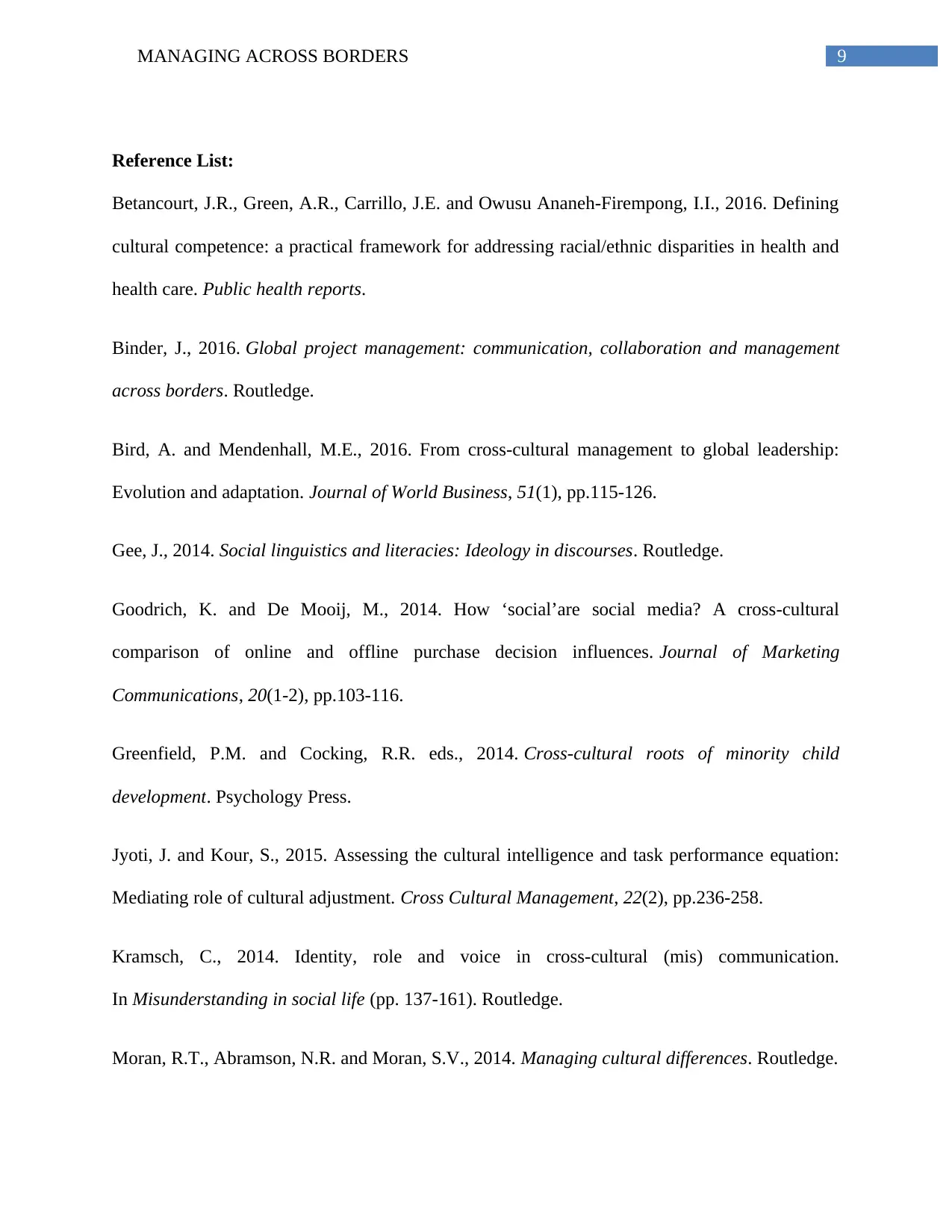
9MANAGING ACROSS BORDERS
Reference List:
Betancourt, J.R., Green, A.R., Carrillo, J.E. and Owusu Ananeh-Firempong, I.I., 2016. Defining
cultural competence: a practical framework for addressing racial/ethnic disparities in health and
health care. Public health reports.
Binder, J., 2016. Global project management: communication, collaboration and management
across borders. Routledge.
Bird, A. and Mendenhall, M.E., 2016. From cross-cultural management to global leadership:
Evolution and adaptation. Journal of World Business, 51(1), pp.115-126.
Gee, J., 2014. Social linguistics and literacies: Ideology in discourses. Routledge.
Goodrich, K. and De Mooij, M., 2014. How ‘social’are social media? A cross-cultural
comparison of online and offline purchase decision influences. Journal of Marketing
Communications, 20(1-2), pp.103-116.
Greenfield, P.M. and Cocking, R.R. eds., 2014. Cross-cultural roots of minority child
development. Psychology Press.
Jyoti, J. and Kour, S., 2015. Assessing the cultural intelligence and task performance equation:
Mediating role of cultural adjustment. Cross Cultural Management, 22(2), pp.236-258.
Kramsch, C., 2014. Identity, role and voice in cross-cultural (mis) communication.
In Misunderstanding in social life (pp. 137-161). Routledge.
Moran, R.T., Abramson, N.R. and Moran, S.V., 2014. Managing cultural differences. Routledge.
Reference List:
Betancourt, J.R., Green, A.R., Carrillo, J.E. and Owusu Ananeh-Firempong, I.I., 2016. Defining
cultural competence: a practical framework for addressing racial/ethnic disparities in health and
health care. Public health reports.
Binder, J., 2016. Global project management: communication, collaboration and management
across borders. Routledge.
Bird, A. and Mendenhall, M.E., 2016. From cross-cultural management to global leadership:
Evolution and adaptation. Journal of World Business, 51(1), pp.115-126.
Gee, J., 2014. Social linguistics and literacies: Ideology in discourses. Routledge.
Goodrich, K. and De Mooij, M., 2014. How ‘social’are social media? A cross-cultural
comparison of online and offline purchase decision influences. Journal of Marketing
Communications, 20(1-2), pp.103-116.
Greenfield, P.M. and Cocking, R.R. eds., 2014. Cross-cultural roots of minority child
development. Psychology Press.
Jyoti, J. and Kour, S., 2015. Assessing the cultural intelligence and task performance equation:
Mediating role of cultural adjustment. Cross Cultural Management, 22(2), pp.236-258.
Kramsch, C., 2014. Identity, role and voice in cross-cultural (mis) communication.
In Misunderstanding in social life (pp. 137-161). Routledge.
Moran, R.T., Abramson, N.R. and Moran, S.V., 2014. Managing cultural differences. Routledge.
Paraphrase This Document
Need a fresh take? Get an instant paraphrase of this document with our AI Paraphraser
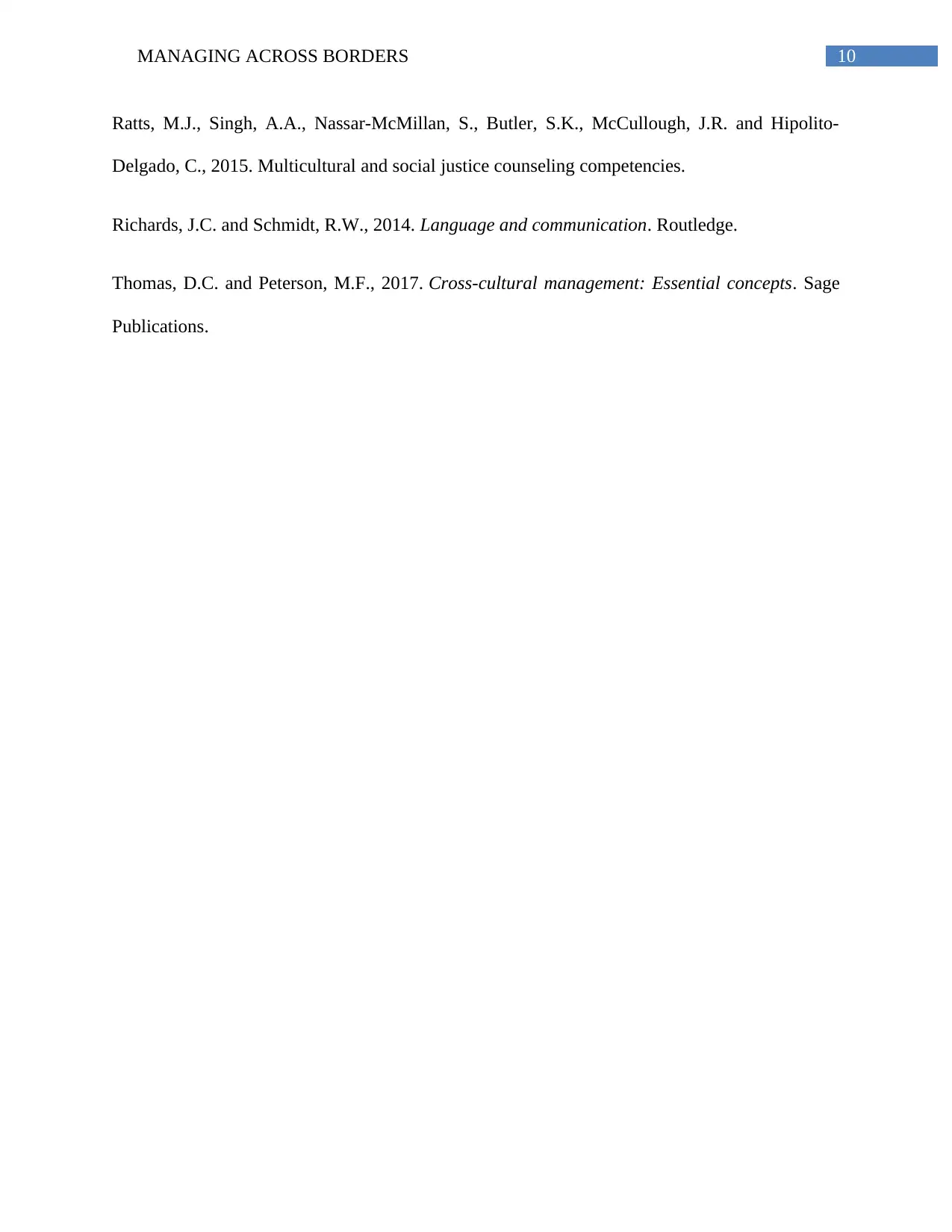
10MANAGING ACROSS BORDERS
Ratts, M.J., Singh, A.A., Nassar-McMillan, S., Butler, S.K., McCullough, J.R. and Hipolito-
Delgado, C., 2015. Multicultural and social justice counseling competencies.
Richards, J.C. and Schmidt, R.W., 2014. Language and communication. Routledge.
Thomas, D.C. and Peterson, M.F., 2017. Cross-cultural management: Essential concepts. Sage
Publications.
Ratts, M.J., Singh, A.A., Nassar-McMillan, S., Butler, S.K., McCullough, J.R. and Hipolito-
Delgado, C., 2015. Multicultural and social justice counseling competencies.
Richards, J.C. and Schmidt, R.W., 2014. Language and communication. Routledge.
Thomas, D.C. and Peterson, M.F., 2017. Cross-cultural management: Essential concepts. Sage
Publications.
1 out of 11
Related Documents
Your All-in-One AI-Powered Toolkit for Academic Success.
+13062052269
info@desklib.com
Available 24*7 on WhatsApp / Email
![[object Object]](/_next/static/media/star-bottom.7253800d.svg)
Unlock your academic potential
Copyright © 2020–2025 A2Z Services. All Rights Reserved. Developed and managed by ZUCOL.





